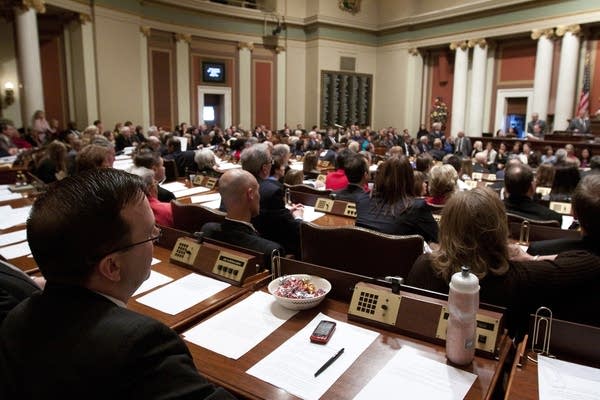House Republicans eye state workforce for budget savings
Go Deeper.
Create an account or log in to save stories.
Like this?
Thanks for liking this story! We have added it to a list of your favorite stories.

Republicans in the Minnesota House are proposing legislation that would cut the number of state employees by 15 percent and freeze their salaries.
Supporters say the bills aim to put the state's workforce more in line with the private sector. But critics say the measures won't help the slow economy or do much to fix the state budget.
Republicans at both the state and national level have made public employees' pay and benefits a key issue in the 2010 campaign. It now appears that they are following through on their promise to cut state government.
Two of the first five bills introduced this legislative session deal with the state's workforce. The bill that would cut the number of state workers would require early retirements, furloughs, layoffs and a hiring feed, said state Rep. Keith Downey, R-Edina.
Turn Up Your Support
MPR News helps you turn down the noise and build shared understanding. Turn up your support for this public resource and keep trusted journalism accessible to all.
"These are the ways we have to think, and if we don't think like that, we're going off a cliff at some point," he said.
Downey said his proposal is designed to restructure the workforce to meet future needs while making the cuts necessary to help erase the state's $6.2 billion budget deficit. He said early retirements will encourage older workers to leave while keeping the state's younger workers in place.
"We have an aging demographic in our state workforce. In fact, kind of a bubble, if you will, of people approaching retirement age," Downey said. "If we hire behind those retirees over the next four years, we'll be simply cementing our labor force. When we talk about reforming government operations, if we don't reform the state employee side of it, it will be difficult to do."
Downey said he isn't sure how much money the plan will save over the next two years. But simple math shows that it won't make a huge dent in the state's budget problems, even if it were fully enacted right away.
Minnesota Finance officials say roughly 35,000 people work in state agencies and departments. A 15 percent cut would result in 5,250 fewer employees. If each made about $50,000 a year, cutting them all would save $525 million -- still leaving the state with a shortfall of nearly $5.7 billion dollars.
In another proposed measure, state Rep. Dennis McNamara, R-Hastings, want to freeze state worker pay for two years.
"This is expecting our public sector neighbors to share in these tough times saying 'hey, let's try to protect as many jobs as we can as we try to find ways to balance the budget.' " McNamara said.
Officials with the two largest public employees unions don't like the proposals.
Eliot Seide, executive director AFSCME Council 5, which represents 20,000 state employees, said cutting the state's workforce would only add to Minnesota's economic problems.
"Every time government cuts a public employee's job, Main Street, particularly in Greater Minnesota, loses a customer," Seide said. "As more stores shutter their doors the last thing we need is to layoff more people."
Jim Monroe, executive director of the Minnesota Association of Professional Employees, said it would be "impossible" to cut 15 percent of the state's workforce without seeing a decline in the services government delivers. He said the state's prisons, nursing homes and other programs still need to function.
"If you cut 15 percent out of the institutions," Monroe asked, "where do you put the bodies, the beds, the people who are in treatment or in custodial care?"
Both Seide and Monroe also say state employees saw no wage increase in four of the past eight years. Despite their objections they say they're willing to work with Gov. Mark Dayton and the Legislature to come up with a budget solution.
The key question is how Dayton, who was supported by both public employee unions during the campaign, handles the situation. His spokeswoman, Andrea Mokros, said he won't look at these budget solutions on their own.
"Clearly cuts are going to have to be made," Mokros said. "However, looking at individual pieces like this without the context of a full package that gets us to a solution of the $6.2 billion budget deficit we're facing isn't going to accomplish what we need to at the end of the day."
Mokros said Dayton will release his budget plan on Feb 15.




